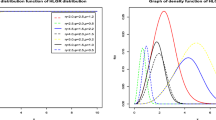Abstract
We present the basic distribution theory of δ-record values, R n,δ , δ≤0, from a sequence of independent and identically distributed random variables from an absolutely continuous parent. We obtain recurrent formulas for the density function of R n,δ and a representation for this random variable that in some sense is similar to Tata’s representation for ordinary records. We also give the probability function of inter-δ-record times and some of its properties. We give examples of our results and also some elements of inference based on δ-records.
Similar content being viewed by others
References
Arnold BC, Balakrishnan N, Nagaraja HN (1998) Records. Wiley series in probability and statistics: probability and statistics. Wiley, New York
Balakrishnan N, Pakes AG, Stepanov A (2005) On the number and sum of near-record observations. Adv Appl Probab 37(3):765–780
Eliazar I (2005) On geometric record times. Physica A 348(1–4):181–198
Embrechts P, Klüppelberg C, Mikosch T (1997) Modelling extremal events. Applications of mathematics (New York), vol 33. Springer, Berlin
Gouet R, López FJ, Sanz G (2007) Asymptotic normality for the counting process of weak records and δ-records in discrete models. Bernoulli 13(3):754–781
Gouet R, López F, Sanz G (2012a) On geometric records: rate of appearance and magnitude. J Stat Mech, Theory Exp 2012(1)
Gouet R, López FJ, Sanz G (2012b) On δ-record observations: asymptotic rates for the counting process and elements of maximum likelihood estimation. Test 21(1):188–214
Neuts MF (1967) Waiting times between record observations. J Appl Probab 4:206–208
Neveu J (1975) Discrete-parameter martingales, revised edn. North-Holland, Amsterdam
Nevzorov VB (2001) Records: mathematical theory. Translations of mathematical monographs, vol 194. American Mathematical Society, Providence
Pakes AG (2007) Limit theorems for numbers of near-records. Extremes 10(4):207–224
Pakes AG, Steutel FW (1997) On the number of records near the maximum. Aust J Stat 39(2):179–192
Siddiqui MM, Biondini RW (1975) The joint distribution of record values and inter-record times. Ann Probab 3(6):1012–1013
Tata MN (1969) On outstanding values in a sequence of random variables. Z Wahrscheinlichkeitstheor Verw Geb 12:9–20
Williams D (1991) Probability with martingales. Cambridge mathematical textbooks. Cambridge University Press, Cambridge
Acknowledgements
We would like to thank the referees for their quick and constructive comments. This research has been supported by Grant MTM2010-16949 of the Spanish Ministry of Education and Science and Grants FQM331, FQM5849 of Junta de Andalucía, Spain.
Author information
Authors and Affiliations
Corresponding author
Rights and permissions
About this article
Cite this article
López-Blázquez, F., Salamanca-Miño, B. Distribution theory of δ-record values. Case δ≤0. TEST 22, 715–738 (2013). https://doi.org/10.1007/s11749-013-0340-8
Received:
Accepted:
Published:
Issue Date:
DOI: https://doi.org/10.1007/s11749-013-0340-8




